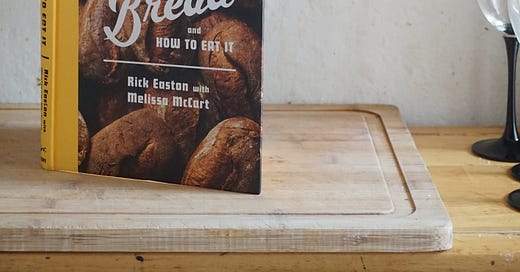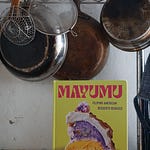On the day I sit down to write this piece and edit this audio, I wake up to a 5:54 a.m. text from my friend Diego. I was bleary-eyed upon waking and didn’t respond immediately, and so he called at 8:57 a.m. He’s the owner and baker behind Panoteca San Miguel, and I think I’ve started a couple of pieces already with moments when he’s called me out of the blue. Random calls from a baker are food writing gold.
The subject matter is almost always besides the point: He’s one of the most enthusiastic and unflappably happy people I know, always up for a collaboration, and he deeply understands the significant intermingling of food and printed matter. (We spoke about the indie food magazine from Argentina Anchoa and me doing a pizza pop-up at the bakery for my book release.)
He lives on the timeline of bread, and bread begins early in the day. I like to get on that wavelength: I’ve been feeling quite down lately—worried about the book release, worried about taxes, worried about Sahara Dust and wildfire skies over the two places I call home—and I needed a dose of positivity. Nothing about life and business are simple, especially not in Puerto Rico, but his focus on flour, flavor, community, and the beauty of early morning sunlight on a freshly baked croissant reminds me what really matters in life is good food and people to eat it with. (Of course, to maintain all of this, we need to do something about the multiple crises we face, but I digress…)
It’s only been in the last few years that I’ve developed an easy-going relationship with bread. I was born, as I say all the time, on Long Island in 1985. This was not a bastion of crusty baguettes and airy sourdough. I refused most bread, especially the white kind; I didn’t see it as food, and usually it would be stuffed with a selection of cold things that I didn’t feel would go well together. Bread was such a fraught subject that I never brought a sandwich to school, and my mom would pack me fried chicken cutlets and a salad. Other kids made fun of me, but I didn’t care, because my food was delicious and, to me, theirs was not. My working mom enabling me in this way, likely turning me into a food writer ready to tell everyone else their palate is wrong (though I hope I rarely actually do this!), is a kindness I will never be able to repay.
Something changed in the late ’90s, and perhaps someone who was more conscious of food then can explain why (I was conscious mainly of Duncan Sheik), and I will never forget being in the local Waldbaum’s supermarket and picking up a round loaf of a sort I’d not encountered before. “Peasant bread” said the sticker, and somehow I knew it was the bread I’d been searching for my whole life. It was around this time that my mom started to make French toast with challah, too; it was a bread renaissance.
I didn’t become a sandwich person overnight. This would take time, and I’d have to endure my mid-twenties wellness phase, during which my big treat for the week would be sweet potato fries with salad at a local pub, paired with precisely one beer. Eventually, I would open my heart up to more bread, but it’s not since I’ve been in San Juan that I’ve become a daily toast consumer. We have quite a few bakeries to choose from, like Diego’s, or El Horno del Pane, or Spiga, or our farmers’ market go-to Levain. We are never without a loaf, unless something has gone wrong, and our daily weekday lunch tends to be a simply dressed green salad, a piece of sourdough toast, and one fried egg each.
Of course, I’ve worried that I’m not a good enough food writer, a good enough cook, without making the sourdough myself. I simply don’t want to, though, and I’m not good at it. We love to make flatbreads, burger buns, and all sorts of bread-type things in the house or in our Ooni, but for the sourdough to continue to be good, be special, be a meditative moment in the middle of hectic days, we need to support a local bakery—and with that support, there’s a community. There’s Diego calling me on the phone; there’s the co-owner of Levain knowing Benny and telling us about her dogs on Saturday mornings.
This is why Bread and How to Eat It by Rick Easton (of Bread and Salt Bakery in Jersey City, New Jersey) and writer Melissa McCart is a breath of fresh air: They don’t want you to make the bread yourself. In fact, they discourage you! They say find a local bakery making bread you like and support them. There’s quite enough to do with bread that’s been made by an expert, anyway.
I love this quite radical spin, this notion that good food begins with being part of a community, which is to me such a crucial aspect of changing food systems to be more equitable and more sustainable. We need to feel we have a stake in what our cities and neighborhoods look like, and that can start with something as simple as getting to know the local baker. What a quaint and old-fashioned notion, but how lost it’s been to time and to our detriment.
Now, this doesn’t mean that I don’t believe people should bake bread at home—not at all! I simply have other day-to-day cooking and recipe development work to do in a very small kitchen, with a volatile tropical climate to contend with, and a lack of easy access to high-quality flour. Our local bakers work in large, temperature-controlled spaces with the ability to buy good flour or grain in bulk. Everything about how we interact with food is contextual.
While surely some will find Easton’s take on this issue eccentric, at best, or rude, at worst, to me, it’s always generative to interact intellectually with ideas that might seem extreme or absurd. What this podcast and this book get at is, at heart, an argument about infrastructure and community: How can we build cities and regions where it’s easier to access community through food? What does it look like when we do? The longer I write about food—as many others have found, as well—the more I realize I’m really writing about cities, transportation, and trade.
Sarah Schulman, writing in the introduction to Conflict Is Not Abuse, states an intellectual position that I’ve adopted: “This is not a book to be agreed with, an exhibition of evidence or a display of proof. It is instead designed for engaged and dynamic interactive collective thinking where some ideas will resonate, others will be rejected, and still others will provoke the readers to produce new knowledge themselves.” Replace “book” with “newsletter,” and there we are.
Bread and How to Eat It is, to me, part of a small wave of new cookbooks that tell us how to use the food we’ve got to the best of its ability in order to both enjoy it and, yes, cut down on food waste. It’s mostly a book about old bread, but not just old bread. There are recipes for French toast, a broccoli rabe sandwich (a sandwich I miss most when not in New York), and a whole chapter on “things to eat with bread,” like cabbage salad. It’s really a counterintuitive cookbook, which makes it exactly the kind of cookbook I will refer to a lot: It doesn’t just tell you how to cook with bread; it teaches you how to think about bread, whether you bake it yourself or go out to buy it. That’s why I wanted to talk to Easton and McCart about how they got to food, why they decided to approach the book this way, and how home bread-baking ties into “American ideas of self-reliance.”
This is a book for those who don’t want to make their own bread, but do want to use good bread well. It’s for everyone who’s felt a little guilt about not having a sourdough starter to feed. It’s a book for anyone who needs to get on the wavelength of a bread baker to feel ready to seize the day. Happiness, on occasion, is simple, and can be just one slice of toast away.
Note: This was my first recording back and I was recovering from allergic bronchitis. I forgot to record everyone on separate tracks—please forgive; this is DIY life. I also know I used to provide transcripts for podcasts, but the software I used went up in price exorbitantly (I do a machine transcript and hand that to a person for cleaning up, then I copyedit). I have found a more reasonable service and will bring them back.
Significant Moments
08:10: How they approached a bread book that isn’t a bread-baking book
13:30: Including what can be considered “ornery” notes on kosher salt, local eggs, and seasonal garlic
15:05: Doing things at Bread and Salt Bakery that Rick doesn’t like, but that sell well and are popular with customers
18:04: What influenced the type of recipes that are in the book, such as traveling in Italy and throughout the Arab world
22:15: The sociopolitical aspects of having a local bakery
27:50: Is simplicity in recipes a philosophy?
This Friday’s From the Kitchen dispatch for paid subscribers will be about my annual love affair with acerola season. It’s a tart Caribbean cherry, and I’m going to share a recipe for a compote that can be used three different ways that are perfect for summer and require very little work. The compote can be made with any firm-fleshed cherry. See the recipe index for all recipes available to paid subscribers.
Published
My small jewelry collection with By Ren is available through the end of 2023. The pearl cocktail picks and peas-in-a-pod ring are in my daily rotation, and I can’t wait to wear the choker on my book tour.
The book—No Meat Required: The Cultural History and Culinary Future of Plant-Based Eating—is out on August 15! Pre-order to kick up some excitement.
Reading
I was re-reading National Dish: Around the World in Search of Food, History, and the Meaning of Home by Anya von Bremzen, out next week. I interviewed her about the book for my forthcoming series on what it means to say “food is political.”
Cooking
Recipe testing for the compote—three times, as always! I honestly can’t remember much else.











Share this post